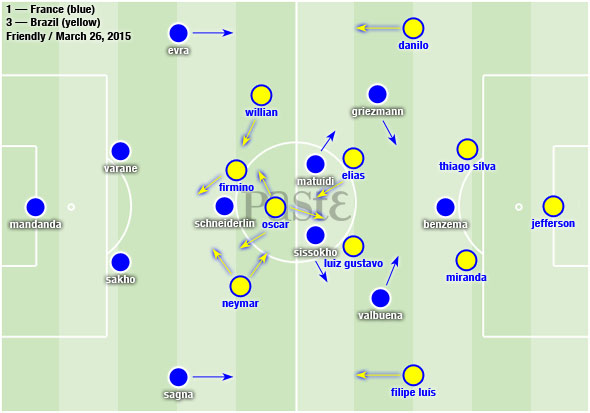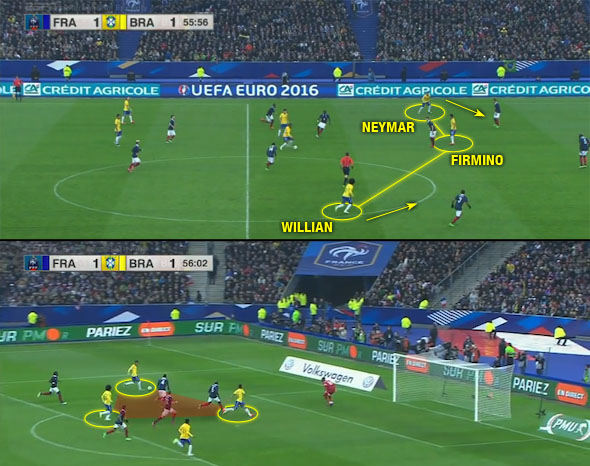Tactical Analysis: France vs. Brazil
A modern rematch of the 1998 World Cup final went a little differently, as Brazil defeated host France, 3-1, in the same Stade de France on Thursday. This time, 1998 captains Didier Deschamps and Dunga faced off from the dugouts, with Dunga’s men getting the victory their predecessors could not.
Both teams put out as strong a lineup as they could, buoyed by their recent form and the atmosphere surrounding the event. Neither team had lost since going out of the World Cup, with Brazil remaining perfect.

Deschamps and Dunga put out slightly different variations of a 4-3-3 system, with Brazil playing two holding men and Morgan Schneiderlin anchoring France alone ahead of its back line. Lacking a true center forward, Brazil played closer to a 4-2-3-1 or 4-2-4, while France looked closer to a 4-1-4-1.
The wing players were key for both, cutting inside frequently and looking for central superiority in attack. Willian and Neymar supported Firmino in the false 9 role for the Seleção, while Antoine Griezmann and Mathieu Valbuena led the charge for Les Bleus.
France’s dynamic and explosive wide men set the team’s tone, with midfield partners Blaise Matuidi and Mamadou Sissokho acting as facilitators with their off-ball movement and distribution. Ahead of them, Karim Benzema missed a couple opportunities to give France a lead, first with a seventh-minute header inside the six-yard box and a volley from another cross on the hour mark.
Botafogo goalkeeper Jefferson, one of two domestic-based players in Brazil’s starting 11, played superbly. He saved Benzema’s early effort, a one-on-one with Sissokho and a long-distance shot from Griezmann.

Brazil controlled possession, with France conceding the ball in the opposing half in particular. Les Bleus maintained a fluid line of confrontation, depending on Brazil’s numbers around the ball and whether it had sustained possession.
As a result, much of Brazil’s early ball circulation looked casual as it probed for openings in France’s defensive block. Lacking a true No. 9 helped in that sense, as Firmino played off the defenders and received below the back line, allowing the other attackers to make disruptive runs.
France’s most dangerous opportunities came on set pieces. Raphaël Varane opened the scoring on a 21st-minute corner, losing Miranda in the penalty area before heading home. Brazil remained patient, funneling much of its attack through Neymar, who wore the captain’s armband as the team’s most indispensable piece since its disastrous World Cup exit.
Upon his hiring, Dunga returned to the fluid-passing philosophy of the Brazilian teams that dominated past generations of international play. Despite playing with no true center forward against France, he normally does line up with a No. 9.
-

-

-

-

-

-

-

-

-

-

-

-

-

-

-

-

-

-

-

-

-

-

-

-

-

-

-

-

-

-

-

-

-

-

-

-

-

-

-

-









































